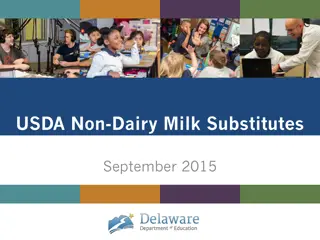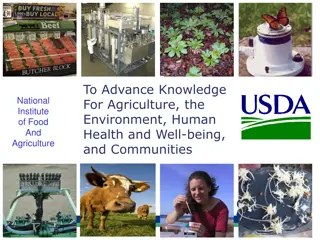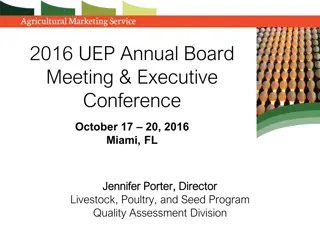USDA TARGET CENTER ERGONOMICS PROGRAM
Workplace ergonomics and the USDA TARGET Center's program for improving workplace health and productivity. Understand risk factors, prevention principles, and resources available for ergonomic support.
0 views • 37 slides
USDA Tribal Relations and Federal Policy in Native Agriculture
Explore the role of the USDA Office of Tribal Relations and the USDA Tribal Advisory Committee in addressing barriers and federal policies impacting tribal agriculture. Learn about tribal eligibility, statutory requirements, and the historical eras of federal Indian policy affecting Native American
0 views • 36 slides
NRCS Programs Update
The Inflation Reduction Act (IRA) provides $20 billion to support USDA's conservation programs focusing on climate-related benefits and agricultural resilience. It allocates funds for programs like the Environmental Quality Incentives Program, Agricultural Conservation Easement Program, Regional Con
2 views • 14 slides
Streamlined Forecasting for Future USDA Foods Utilization
Cathy Sparks, National Commodity Director, discusses the importance of communication in the forecasting process for USDA foods. Tools like the ProcessorLink calculator and K12 On Target planner help processors and distributors estimate quantities needed for production. Commodity Planning Made Easy s
1 views • 9 slides
USDA DEIA Strategic Plan Overview
The United States Department of Agriculture (USDA) is prioritizing Diversity, Equity, Inclusion, and Accessibility (DEIA) through various initiatives and actions. The agency is focused on promoting a diverse workforce, ensuring equitable access to programs, and fostering an inclusive workplace envir
1 views • 12 slides
USDA Accessible Communications Program Overview
Advancing access and equity for individuals with disabilities is a key focus of the USDA Accessible Communications Program. Through initiatives like the National Disability Employment Awareness Month events and implementing the Rehabilitation Act, the program aims to promote accessible communication
5 views • 28 slides
Building a Trauma-Informed Workplace for Equitable Employment: USDA Symposium 2023
Explore the imperative of creating trauma-informed workplaces at the National Disability Employment Awareness Month Symposium hosted by USDA Target Center. The event sheds light on the prevalence of workplace trauma, its impact on mental health, and steps to advance access and equity. Gain insights
2 views • 36 slides
Effective USDA Foods Procurement and Forecasting Strategies
Managing USDA Foods procurement involves analyzing historical data, estimating future trends, and streamlining menu planning to save time and reduce costs. Standardized recipes and inventory management are crucial for efficient operations. Understanding the location and value of USDA Foods, along wi
8 views • 11 slides
Ongoing USDA Programs and Biotechnology Research Overview
This overview delves into ongoing USDA programs such as the Biotechnology Risk Assessment Grants (BRAG) Program, which supports biotechnology research. The program covers risk assessment, management, pollen flow research, gene transfer control methods, and more. Additionally, voluntary market facili
0 views • 16 slides
USDA Civil Rights Training for TEFAP Program
The USDA Civil Rights Training emphasizes the importance of training for state agencies, subrecipient agencies, frontline staff, and volunteers involved in the Emergency Food Assistance Program (TEFAP). It covers various aspects of Civil Rights compliance, including public notification, complaint pr
0 views • 48 slides
New Employee Benefits Overview for USDA APHIS and AMS Employees
Get insights into the array of benefits available for eligible employees of USDA APHIS and AMS, including details on life insurance, health insurance, dental and vision insurance, flexible spending accounts, retirement plans, and more. Understand eligibility criteria based on appointment types and w
0 views • 24 slides
Understanding G-Invoicing Implementation at USDA
G-Invoicing is an online portal facilitating electronic information exchange for interagency agreements among Federal agencies. The system streamlines invoicing processes, standardizes transactions, and enhances communication for reimbursable activities. The implementation at USDA involves mandatory
0 views • 26 slides
USDA In-Person Sign Language Interpreting Services Training Overview
This training session provides essential information for USDA employees on requesting in-person and virtual sign language interpreting services in the National Capital Region. It covers policy reviews, training completion, requesting procedures, and resources available through the USDA NCR Sign Lang
0 views • 23 slides
USDA REE Mission Area Overview and Procurement Guidelines
The United States Department of Agriculture's Research, Education, and Economics (REE) mission area comprises four agencies dedicated to enhancing the food and fiber system. The REE agencies facilitate procurements for various services and equipment, striving to achieve small business participation
1 views • 11 slides
Understanding the Working Capital Fund: Governance, Services, and Structure
The Working Capital Fund (WCF), established in 1944, is a fund without fiscal year limitation that supports centrally-managed Activity Centers providing various services such as Information Technology, Financial Management, and Administrative Services to USDA and Non-USDA organizations. The WCF empl
0 views • 11 slides
USDA CXO Dashboards for Data-Driven Decision-Making
This document outlines the progress and plans for implementing CXO Dashboards within the USDA to enable data-driven decisions. It covers the purpose, accomplishments, current status, timeline, and risk assessment of the project. Key highlights include the development of executive and OCIO dashboards
0 views • 9 slides
Understanding USDA Watershed Programs for Local Communities
USDA Watershed Programs offer assistance in addressing natural resource issues such as flood control, repairing flood damages, and rehabilitating flood control dams. The three major components - Emergency Watershed Program (EWP), Watershed Protection and Flood Control Program (WPFO), and Watershed R
0 views • 15 slides
USDA Robotic Process Automation (RPA) Assessment and Development Process
The USDA conducted a Robotic Process Automation (RPA) Process Assessment in July 2019, involving process robotics capabilities, development process under the Federated Model, and the lifecycle of a bot project. The RPA development process includes steps like requesting automation, process definition
1 views • 17 slides
United States Department of Agriculture Civil Rights Training Overview
This overview provides information on Civil Rights Training conducted by the United States Department of Agriculture (USDA), covering legal authorities, areas of compliance, public notification, data collection, and more. The training focuses on ensuring equal opportunity and non-discrimination in U
1 views • 35 slides
Hemp Acreage Reporting & Certification Q&A with USDA
Explore essential information about Hemp Acreage Reporting, Certification, and compliance procedures in this Q&A session with the Farm Service Agency (USDA). Learn about important deadlines, required documentation, and the significance of reporting accuracy for various programs. Discover how to file
0 views • 15 slides
USDA Rural Development Contracting Overview
USDA Rural Development's procurement activities focus on supporting small businesses through various contracting divisions and contract types, with a significant achievement in small business contracting in FY22. The agency's top spending categories include professional, scientific, and technical se
0 views • 8 slides
Overview of Child and Adult Care Food Program (CACFP)
The Child and Adult Care Food Program (CACFP) is a federally funded program aimed at subsidizing eligible institutions to provide nutritious meals to children and adults, promoting lifelong healthy eating and physical activity habits. Administered by the USDA and implemented by various programs, CAC
0 views • 21 slides
USDA Non-Dairy Milk Substitutes September 2015
Explore the USDA regulations and guidelines for non-dairy milk substitutes, focusing on cow's milk and soy milk. Learn about food allergies versus intolerances and the importance of approved substitutions. Understand the serving regulations for milk in CACFP meals and the accommodations required for
1 views • 11 slides
USDA Pesticide Data Program Overview
The USDA Pesticide Data Program (PDP) provides high-quality pesticide residue data for US foods to support regulatory decision-making and ensure food safety. Through cooperative agreements with participating states, the program conducts sampling of various commodities, including fresh fruits and veg
0 views • 17 slides
USDA SBIR Program Overview for Innovation in Agriculture and Technology
The USDA SBIR program supports innovative projects in agriculture, the environment, and human health. It offers grants for ideas based on scientific merit and commercial potential. With Phase I and Phase II grants available, entrepreneurs can receive funding and commercialization assistance for thei
0 views • 24 slides
Overview of USDA Foods Programs and Delivery Methods
The USDA Foods Programs offer various initiatives like Direct Delivery, Diversion/Processing, DoD Fresh Fruit and Vegetable Program, and Unprocessed Fruit and Vegetable Pilot. These programs provide schools with access to a wide range of food products procured through different methods, including bu
1 views • 10 slides
Overview of USDA Food Distribution Program
The USDA Food Distribution Program aims to support American agricultural markets and provide nutritious food to schools. With over 17 million entitlements distributed annually, the program ensures that USDA foods are domestic and meet nutritional goals. Service fees cover various administrative cost
0 views • 15 slides
Managing USDA Food Receiving and Inventory Basics
Learn about the processes involved in receiving USDA foods, managing inventory using FIFO, understanding storage conditions, determining expiration dates, and interpreting best-if-used-by dates. Ensure proper handling and storage to maintain food quality and safety.
0 views • 15 slides
Enhancing Inclusive Communications at USDA: A Program Overview
Explore the USDA's accessible communications program aimed at promoting inclusivity nationwide and celebrating National Disability Employment Awareness Month. Learn about key objectives, initiatives to create accessible and inclusive communication experiences, and the benefits of such practices for
0 views • 36 slides
USDA Foods Ordering Overview: Direct Delivery and Diversion Process
This overview provides detailed information on the USDA Foods Ordering process, focusing on Direct Delivery and Diversion options. Learn about ordering breakdowns, timelines, reminders, and programs like DoD Fresh Fruit and Vegetable. Understand the steps to order in advance, schedule deliveries, se
0 views • 13 slides
Responding to Child Nutrition Programs in Disasters
Learn how Child Nutrition Programs can effectively respond to disaster situations, including utilizing USDA Foods and programs like CACFP, SFSP, and D-SNAP. Discover methods, preparation steps, types of declarations, sources of USDA Foods, and inventory management strategies for efficient disaster r
0 views • 27 slides
Identifying USDA Grade for Exterior Egg Shell Quality
This content presents images of individual eggs and asks users to place the USDA grade for each egg's exterior shell quality. The images provide a visual assessment challenge for viewers to gauge shell quality based on USDA standards.
0 views • 15 slides
USDA Foods Purchases and Certification Updates
The document highlights the USDA's food purchases over the fiscal years, as well as updates on AMS grading and certification processes. It includes information on biosecurity measures, sampling rate revisions, and vigilance protocols. The data reflects purchases of shell eggs, dried eggs, and egg pr
0 views • 11 slides
USDA Foods Program Overview: School Lunch Program Details
Schools and agencies participating in the National School Lunch Program can receive USDA Foods, with entitlement rates set annually by the USDA. The program includes direct and processed options, along with specific delivery schedules and administrative fees. Ordering takes place once a year, with o
0 views • 19 slides
USDA Small Business Activities Overview and Strategies
United States Department of Agriculture (USDA) Procurement Operations Divisions (PODs) have exceeded small business contracting goals, with over $1.1 billion in new obligations in FY 2021. Their objectives include efficient acquisition methodologies, partnering with emerging small businesses, and aw
0 views • 13 slides
Efficient USDA Food Distribution Program Management System
Explore the advantages of the Web Based Supply Chain Management System (WBSCM) for managing USDA Food Distribution Programs in Texas. Learn about key functionalities such as user roles, order management, organization administration, and access levels. Ensure seamless operation by utilizing WBSCM's r
0 views • 9 slides
USDA Office of the Chief Scientist Overview
The USDA Office of the Chief Scientist (OCS) plays a crucial role in facilitating scientific coordination and collaboration across USDA agencies. It comprises a structured organizational setup with key positions dedicated to scientific integrity, communication, and coordination. The Acting Chief Sci
0 views • 12 slides
USDA Fleet Card Program Usage Procedures
The United States Department of Agriculture (USDA) outlines the procedures and guidelines for using the USDA-authorized Wright Express (WEX) Fleet Card for fuel, maintenance, and repair services for USDA-owned and commercially-leased vehicles. The program covers specific authorized uses such as fuel
0 views • 12 slides
USDA Office of Technology Transfer Patent Program Overview
USDA Office of Technology Transfer's Patent Program provides professional services for creating, managing, and convening Utility Patent Review Committees, preparing and prosecuting U.S. patent applications, advising on patent policies, and facilitating foreign filings. The process for protecting USD
0 views • 24 slides
Understanding USDA Foods State Processing Agreements in Oregon
The Oregon Department of Education works with state distributing agencies and school districts to leverage USDA Foods and convert them into convenient end products through processing agreements. Various levels of government can make regulations regarding nonprofit food service accounts, ensuring com
0 views • 13 slides







































